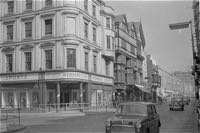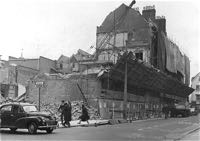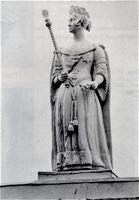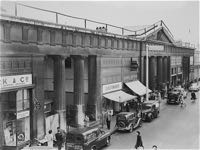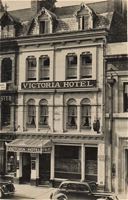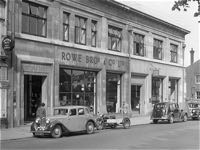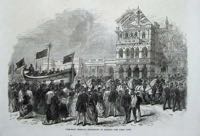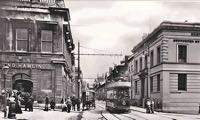
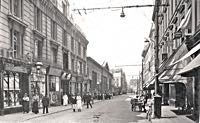 Queen Street
Queen Street
Page updated 22nd February 2018
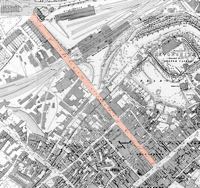 The Improvement
Commissioners (Victorian town planners) were responsible for the
construction of Queen Street, which was cut between 1839 and 1841. It
ran from the High Street to the also new, New North Road which crossed the
Longbrook Valley with a viaduct, to join with Longbrook Street.
The Improvement
Commissioners (Victorian town planners) were responsible for the
construction of Queen Street, which was cut between 1839 and 1841. It
ran from the High Street to the also new, New North Road which crossed the
Longbrook Valley with a viaduct, to join with Longbrook Street.
Queen Street was originally designed to link up with the Crediton and Barnstaple turnpikes, before the coming of the railway, at St David's in 1844, increased the importance of the street. The Swan Inn, in the High Street was demolished to make the gap for the new street, and the fish market was also swept away. It was named in 1839, when it became an official public thoroughfare. The roadway through to New North Road was not yet complete, and the width of the finished section was variable. The Commission moved to compulsorily purchase land on each side to give it a uniform width of 38ft, and two surveyors appointed to value the required land.
In 1840, a new Act of Parliament was passed to continue Queen Street from the Higher Market to New North Road. The Exeter Dispensary, on the corner of Northernhay Street opened in 1841, as a clinic for the poor. It took many more years for all the spare land on each side be filled in with buildings.
Tour of Queen Street
The first building on the left, Marks and Spencer has a 1980, white, pre-cast concrete facsimile of the original building on the site, and a new corner section. The statue of Queen Victoria, which overlooks Queen Street, is a fibreglass copy of the original. The Lion and Unicorn statues over Broom Reid and Harris have been put back, on the new facade.
On the opposite corner, is what is considered to be one of the ugliest, modern buildings in Exeter, built for C & A and now housing Tesco and Sports Direct. Wheatons and Boots both occupied this corner plot, part of the block between the High Street and Little Queen Street that was built between 1843 and 1849 by Nathaniel Cole. The demolition in 1971 was a totally unnecessary development sanctioned by a Council that is more concerned with rateable value than with a pleasant, well balanced townscape.
The Higher Market was originally designed by John Dymond, and completed by Devon born Charles Fowler, after Dymond died at the age of 38. The building displays a magnificent façade of Doric columns. Late in the 19th century, shops-fronts were installed along the Queen Street front of the market, requiring the removal of some pilasters on each side of the central Doric column area. Greenslades Tours, H Quick & Co wholesalers of leather, and others, traded from here. The market closed in 1962 and was incorporated into the Golden Heart project to construct the Guildhall Centre in the 1970s. During 2015/16, the shops in the market were vacated for a major redevelopment scheme to turn it into a new area for restaurants and cafes. The gaps in the front, were blocked in and the space behind turned into restaurants, just as they were shops up until 1972.
Opposite the Higher Market is the rather magnificent Queens Chambers, that were originally constructed as Exeter's first, purpose built post office. On the corner of Paul Street is Las Iguanos, which is the original site of the Episcopal School.
A little further up the street, the Royal Albert Memorial Museum, was constructed in 1869. The building on the left of the museum was built as the County Fire Office, which was the starting point for a parade of a new lifeboat for Brixham in 1866. The 1879 Rougemont Hotel can be found opposite Central Station. The hotel replaced the old City Bridewell, dating from 1819. The station was known as Queen Street Station before it burnt down in June 1927. It was rebuilt as Central Station in 1934, with a new frontage facing the road. Opposite the station, behind the Angel bar, was the Victoria Hall. Exeter's first film show was given here in October 1896—the hall was burnt down in October 1919. Rowe brothers constructed a modern showroom for their building materials business on the empty site. It is now part of Exeter College.
The last building of note is a lovely 19th-century stucco terrace of restaurants and offices, opposite the ugly modern telephone exchange and old Devon General office block. They were built in 1841 by a Mr George Ferris–later in the year, upon completion, the Improvement Commission ordered that they be paved in front of the roadway. The full stop of the Clocktower brings Queen Street to a close.
Sources: Previous research for other pages in Exeter Memories and the British Newspaper Archive.
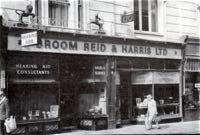
Broom, Reid and Harris was rebuilt to become the side of Marks and Spencer. Note the Lion and Unicorn statues.
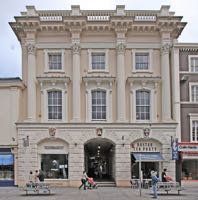
Queen's Chambers was once the post office, and even the Girls Middle School before it moved to become Bishop Blackall School.
│ Top of Page │
